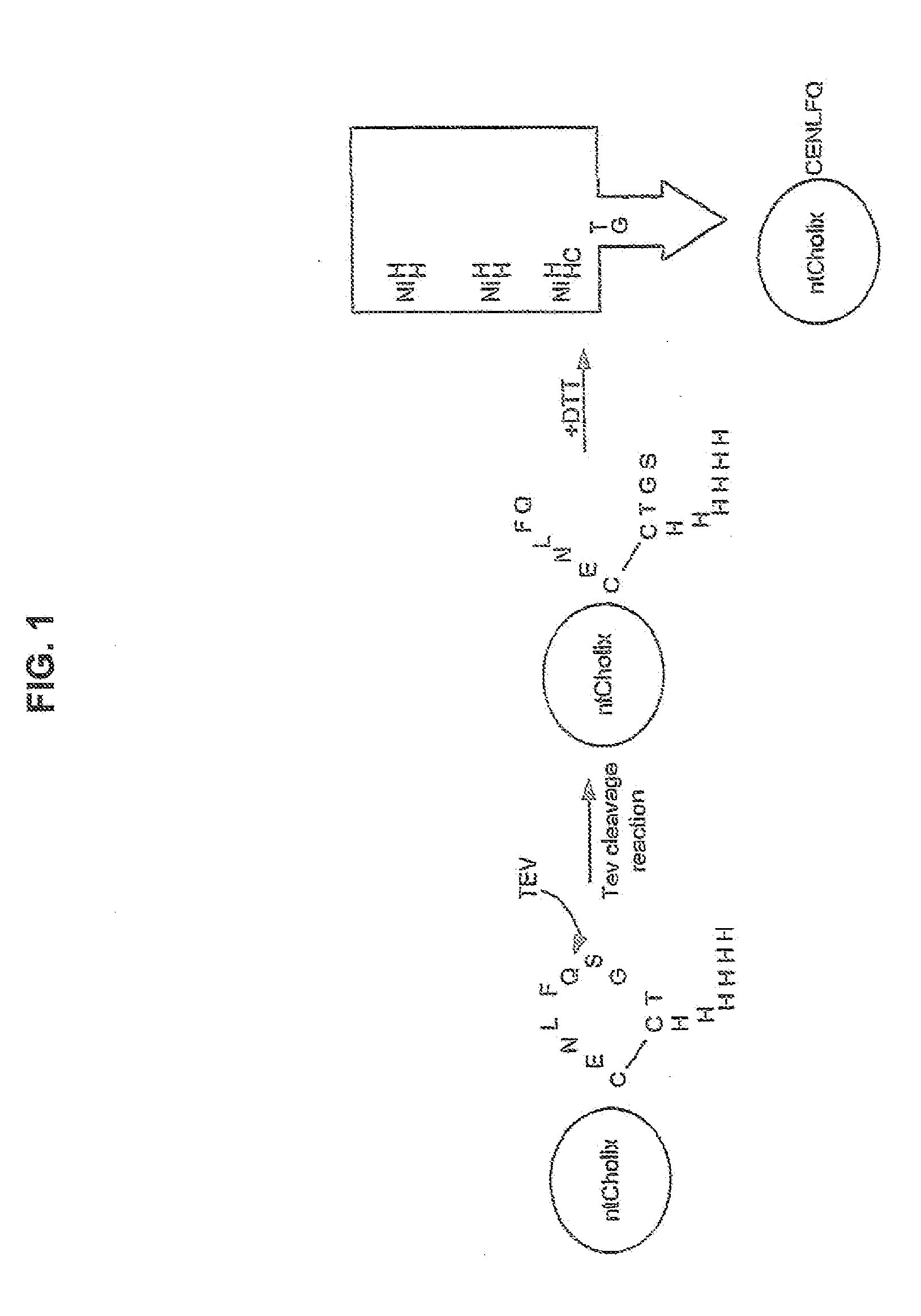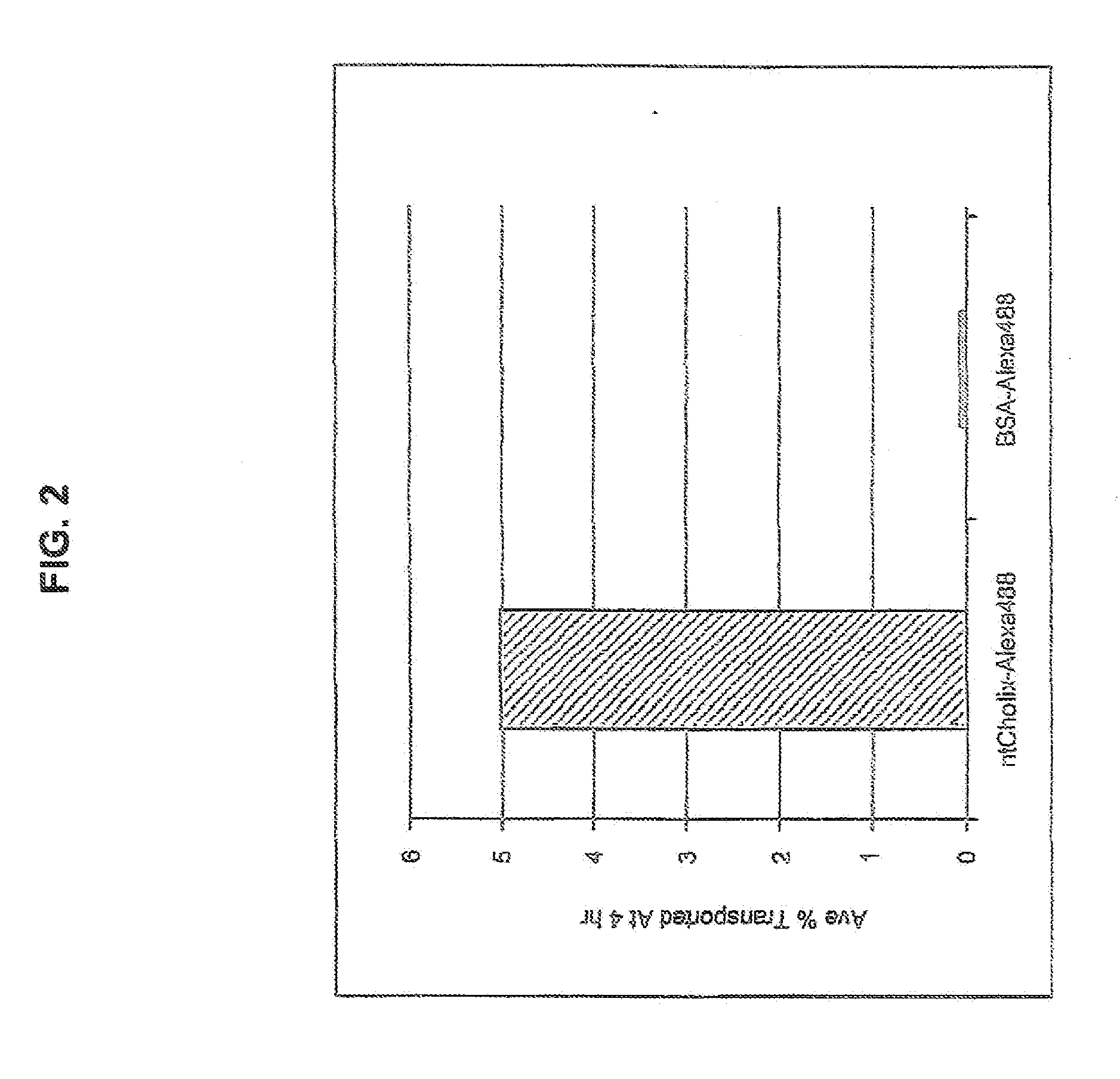Systems and methods of delivery of bioactive agents using bacterial toxin-derived transport sequences
a technology of bioactive agents and transport sequences, applied in the direction of drug compositions, dispersed delivery, immunological disorders, etc., can solve the problems of inability to work well, inconvenient delivery, and inability to meet any kind of match,
- Summary
- Abstract
- Description
- Claims
- Application Information
AI Technical Summary
Benefits of technology
Problems solved by technology
Method used
Image
Examples
example 1
[0056]A plasmid construct was prepared encoding mature Vibrio cholera Cholix and used to express the mature Cholix protein in an E. coli expression system as previously described; see, e.g., Jorgensen, R. et al., J Biol Chem, 283(16):10671-10678 (2008). A non-toxic mutant form of the Cholix gene (hereinafter referred to as “ntCholix”) was also prepared by genetic deletion of a glutamic acid at amino acid position 581 (ΔE581) which is analogous to a deletion (ΔE553) in the PE protein that renders it non-toxic without significantly altering its conformation; Killeen, K. P. and Collier, R. J., Biochim Biophys Acta, 1138:162-166 (1992). Protein expression was achieved using E. coli DH5α cells (Invitrogen, Carlsbad, Calif.) following transformation by heat-shock (1 min at 42° C.) with the appropriate plasmid. Transformed cells, selected on antibiotic-containing media, were isolated and grown in Luria-Bertani broth (Difco). Protein expression was induced by addition of 1 mM isopropyl-D-th...
example 2
[0058]Trans-epithelial transport of ntCholix-Alexa488 was assessed using Caco-2 monolayers in vitro. First, Caco-2 cells (passage number 25-35) were grown to confluent monolayers as previously described; Rubas, W. et al.,Pharm Res, 10:113-118 (1993). Briefly, cells were maintained at 37° C. in DMEM / high growth media enriched with 2 mM L-glutamine, 10% fetal bovine serum, and 100 Units of penicillin / streptomycin in an atmosphere of 5% CO2 and 90% humidity. Cells were passaged every week at a split ratio of 1:3 in 75 cm2 flasks and seeded onto prewetted and collagen-coated permeable (0.4 μm pore size) polycarbonate (Transwell™) filter supports from Corning Costar (Cambridge, Mass.) at a density of 63,000 cells / cm2. Growth media was replaced every other day. Confluent monolayers, determined by the acquisition of significant trans-epithelial resistance (TEER) determine using an volt-ohm-meter (World Precision Instruments, Sarasota, Fla.), were used 20-26 days post seeding.
[0059]Two addi...
example 3
[0062]Also prepared and expressed in E. coli. was a variant of Cholix truncated at amino acid A386 (Cholix386) as well as a genetic ligation of green fluorescent protein (GFP) at the C-terminus of Cholix386 (Cholix386GFP). Protein expression was achieved using E. coli DH5α cells (Invitrogen, Carlsbad, Calif.) following transformation by heat-shock (1 min at 42° C.) with the appropriate plasmid. Transformed cells, selected on antibiotic-containing media, were isolated and grown in Luria-Bertani broth (Difco). Protein expression was induced by addition of 1 mM isopropyl-D-thiogalactopyranoside (IPTG). Two hours following IPTG induction, cells were harvested by centrifugation at 5,000×g for 10 min at 4° C. Inclusion bodies were isolated following cell lysis and proteins were solubilized in 6 M guanidine HCl and 2 mM EDTA (pH 8.0) plus 65 mM dithiothreitol. Following refolding and purification, proteins were stored at ˜5 ml / ml in PBS (pH 7.4) lacking Ca2+ and Mg2+ at −80° C. Cholix386GF...
PUM
 Login to View More
Login to View More Abstract
Description
Claims
Application Information
 Login to View More
Login to View More - R&D
- Intellectual Property
- Life Sciences
- Materials
- Tech Scout
- Unparalleled Data Quality
- Higher Quality Content
- 60% Fewer Hallucinations
Browse by: Latest US Patents, China's latest patents, Technical Efficacy Thesaurus, Application Domain, Technology Topic, Popular Technical Reports.
© 2025 PatSnap. All rights reserved.Legal|Privacy policy|Modern Slavery Act Transparency Statement|Sitemap|About US| Contact US: help@patsnap.com


